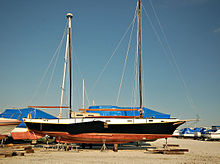


A leeboard is a form of pivoting keel used by a sailboat largely and very often in lieu of a fixed keel. Typically mounted in pairs on each side of a hull, leeboards function much like a centreboard, allowing shallow-draft craft to ply waters fixed keel boats cannot. Only the leeward side leeboard is used at any time, as it submerges when the boat heels under the force of the wind.
A disadvantage, where there is an inadequate fixed keel, is that they typically ship (bear) little ballast, which being on the far side delays the onset of unballasted craft's heeling, that is, to put up a good, constant resistance against the wind. The classical, archetypal definition of ballast is a low, central weight to optimise centre of mass, reduce turning moment and therefore resistance to the boat keeling over, however tends to be higher in self-righting vessels. Modern developments allow them to act as a speed-enhancing lifting foil.